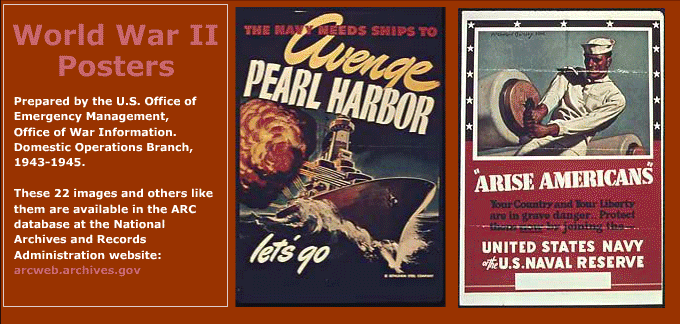No period of time, like the decade of the 1960's, exists in a vacuum. Historical periods exist only as a part of a continuum, with causes, effects, and repercussions stretching both into the past and the future. The events and psychology of the 60's are most easily understood if we go back to the watershed years of World War II, when Americans were as united as they can be in the cause of defeating an enemy who attacked the American fleet at Pearl Harbor and its Axis allies in Germany and Italy. In general the war effort was backed by American citizens of every stripe and derivation. German and Japanese sympathizers were silenced, and Japanese-Americans on the West coast were put in detention camps for the duration.
Even though the war was fought on foreign battlefields outside the perimeter of North America, the civilian population of the U.S. were caught up in air raid drills, the draft, and the rationing of food and some articles of clothing, such as shoes and boots. The production of automobiles, and everything that were deemed nonessential to the war effort was reduced or discontinued for the "duration" of the war. Gasoline was reduced to a minimum distribution to auto owners, according to how much of their travel was necessitated by the war effort. Prices were frozen and adjudicated by the OPA (Office of Price Administration) and hoarding and black marketing of food, fuel, and goods illegally obtained was a felony.
The draft, which had been instituted just before the War, was in high gear with all males required to register at eighteen years of age and older, as local draft boards began to process able bodied men up to their middle and late forties with very few exceptions.
Pearl Harbor had seen enormous volunteerism for the service but as the war wore on, every man had to take his chances with the draft. Women, who had principally been homemakers and mothers, were called on to work as volunteers for war-time production jobs and join the service for such clerical tasks, etc. as were deemed appropriate to their sex.
Women were officially encouraged to take jobs formerly occupied by men. Women were paid equal pay for comparable work, temporarily shattering the idea of wage discrimination for women, and launched them on a path that they would never fully relinquish toward gender equality. When the war was over, and the country had to return to peace-time status, these women had to be lured back into their homes principally by the advertising of former defense contractors like General Electric showing new labor saving devices on the new television sets just coming on the market in the fifties, and glorifying family values in shows like "The Brady Bunch," "Father Knows Best," "Ozzie and Harriet," etc.
Another aspect of the war accentuated the inequities of black men returning home to their former subservience after having received some measure of equal treatment from the military. Once again deprived of the civil liberties they had been told they were fighting for, the full sense of American inequities toward blacks was emphasized. The full intensity of the civil rights struggle that began in the South during the 50's and its repercussions are still being felt today.
America's monopoly on world power seemed unchallenged after the atomic bombs were dropped on Hiroshima and Nagasaki, concluding the War with unconditional victory. In our fervor to retain this ultimate power over destruction we became more and more wary of threats to our hegemony, particularly from communist countries. Weaponry like rockets and the atomic secrets, that the Germans had been developing toward the end of the conflict, became the prizes of war we sought to wrest away from the Soviets, as both countries attempted to invite/capture as many of the German rocket experts and scientists as we could. When it became apparent that the U.S. no longer had sole possession of the secrets of atomic energy or rocketry, Senator Joseph McCarthy set out on a zealous paranoid trail to plug the leaks in the dike by putting everyone with any alleged connection with communist sympathizers on public trial and exposure in a massive political intimidation of artists, writers,
academics, and other left wing intellectuals all over the country.
When North Korea invaded South Korea the U.S. had to reassert itself as the bulwark against communism, and fought an enormously expensive war with the North Koreans and their allies, the Communist Chinese, up and down the Korean Peninsula. The draft was reinstated in the U.S. and America found itself engaged in violent confrontation in all the countries we heedlessly sought to occupy.
At home during the 50's the country began to flourish under the generous educational benefits accorded the veterans, and government-sponsored low interest rate loans for people to buy new homes, precipitated a building boom that was interrupted by WW II but now continues up to the present day. The McCarthy era and the cold war continued through the Korean truce and right into the sixties when the U.S. extended the battle against communism to Viet Nam, the one place and era that divided the country as no conflict had done since our own Civil War.
